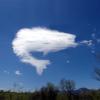The moon and the spawn:
I too have been keenly interested in the moon's influence, because of what I've read and from a mere handful of personal observations enough to get me serious about looking into it.
Here's my understanding so far:
Temperature is critical in fish spawning, in general. The scientific literature says that bass eggs suffer high mortality at 55F. Now I'm assuming this is the "hatchery northern largemouth" (stocked all over), and thus this number may not apply to surviving native strains in pockets throughout the country, or for the Florida subspecies. Thus temps need to be above that if a female is to be successful.
Further, bass are known to initiate spawning when water temperatures stabilize above 60F. Stabilization is noticeable if you bother to keep a running tab. It happens when the days get long enough to defeat the nights cooling and water (which returns heat slowly) reaches a certain level of heat that the night now cannot steal away.
The vast majority of the moon information comes from anglers, along with some angler catch statistics compiled by researchers. These "studies" have shown trends toward moon activity, but in general it's far from definitive. Catch data in my view says more about fishing than the bass' behavior there are just too many variables. Statistically these retrospective reviews are very weak, at best, and considering the sampling method (fishing), I do not feel they offer very much. As for angler theory, there are well known anglers out there espousing very different theories: Full, New, Half, three-quarter to full, full to quarter, and others. If all were correct, then there just isn't a time not to kill em, or angler moon theory is bunk. But maybe some are correct, or offer something.
What I've seen personally in the past was what I thought was full moon influence on females, both at time of egg laying (initially temp influenced they don't spawn on a too early moon), but also prior. But these observations although intense, are really few in number. So I decided to really check it out a couple years ago and started observing the spawn not just fishing it. I chose small waters in which I could see the fish, and recorded what I could given the time I had truly insufficient. I tried to initiate some help from other local on-line anglers but that didn't pan out too well too much time required and no training in what to look for and where to apply one's time. Heck, most people want to fish in their free time, not diligently record behavior and just as important, the lack thereof.
You can visit my attempts in the Colorado Reports page on another site, it's called The Moon and Spawn Journal. It's long and full of observations, and the final result for the first year was not definitive. But I was able to exclude the full moon for egg laying. Nest building in males coincided with the new moon but it also came immediately after a warming trend which probably better explains it especially since egg laying also came on the heels of the next intense warming trend, which fell right in between the new and full thus excluding both.
I haven't written off the moon. I recognize the limitations of my efforts and understanding. As you can see this is complicated and it'll take some time (years) before I can satisfy myself one way or the other. Now if I had a stable of grad students at my beckon call, this could be covered much more effectively -it might only take three years to better refine the questions. Yes, science is painstakingly slow whereas opinion is often instantaneous (LOL).
As it is I'll be looking again this spring, but not likely recording everything on-line.
















